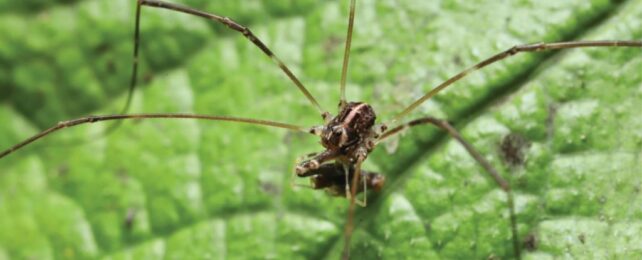Scientists have found a rare species of arachnid in New Zealand that hosts three different types of males. Recent findings on the species are forcing a rethink of animal mating systems and the evolution of reproductive strategies.
First, a brief look back. We've known since 2020 that while male harvestmen (Forsteropsalis pureora) – or daddy longlegs, as you might better know them – look the same and have similar genes, there seemed to be three distinct types.
At the top of the hierarchy sits the large alpha male, which has short yet strong pincer-like jaws that it uses to pin down competition when fighting for territory or mates.
Next comes the beta male, which has longer and thinner pincers. And in last place is the gamma male, which is seven times smaller than the other two.
Not only do gamma males look different from the others, but they also act differently.
Instead of battling for female mates like their larger peers, researchers found these smaller, weaponless males have all but given up the fight.
Their tactic for survival involves sneaking around and looking for undefended females to reproduce with.
The rare pecking order is known as trimorphism, and researchers only discovered it among animals for the first time in 2009.
Now, researchers at the University of Auckland – many of whom conducted the 2020 study – think they have figured out why trimorphism evolves among harvestmen in particular.
According to the new study, if a male harvestman loses a leg in his youth, voluntarily 'dropping' a limb to avoid a hungry predator, the harvestman can't regrow the lost limb and is 45 times more likely to grow up smaller and weaker than his peers.
"Perhaps this is because they can't get enough food for their development because their hunting is impeded," posits evolutionary ecologist Erin Powell.
"Or maybe there's no point in investing in big fighting weapons when they're already disadvantaged when it comes to fighting. So, the arachnids' resources may be invested in other things, such as testes size, sperm count, or aerobic poise, to ensure they make the most of the mating opportunities they get."
The latter possibility is particularly intriguing as it suggests that male harvestmen can permanently 'lay down their weapons' and adopt a new lifestyle that doesn't rely on competition. So even when males have fewer legs to stand on, they can still find ways to reproduce.
If that's the case, then Charles Darwin's theory of sexual selection, which puts great emphasis on sexual ornaments and weapons, may not be fully comprehensive; there could be other ways to snag a mate in nature.
In fact, the same male dung beetles that Darwin once used to support his theory of sexual selection over a century ago, turned out to be trimorphic as well. This means that not all male dung beetles possess large mandibles for fighting other males or wooing females.
While trimorphism can be a result of different genetics, creating various male roles in a society, in the case of dung beetles and harvestmen, the phenomenon seems to have less to do with how animals are born and more to do with how they grow up.
What happens in their youth seems to determine how they develop sexually.
Further research will be needed to explore what sets alpha and beta males apart.
"With their ridiculous towering weaponry and extreme male size variation, New Zealand harvestmen are both charming and puzzling," says Powell.
"We still have much to learn about their fascinating biology, and they have much to teach us about the evolution of mating systems across animal taxa."
The study was published in Behavioral Ecology.
